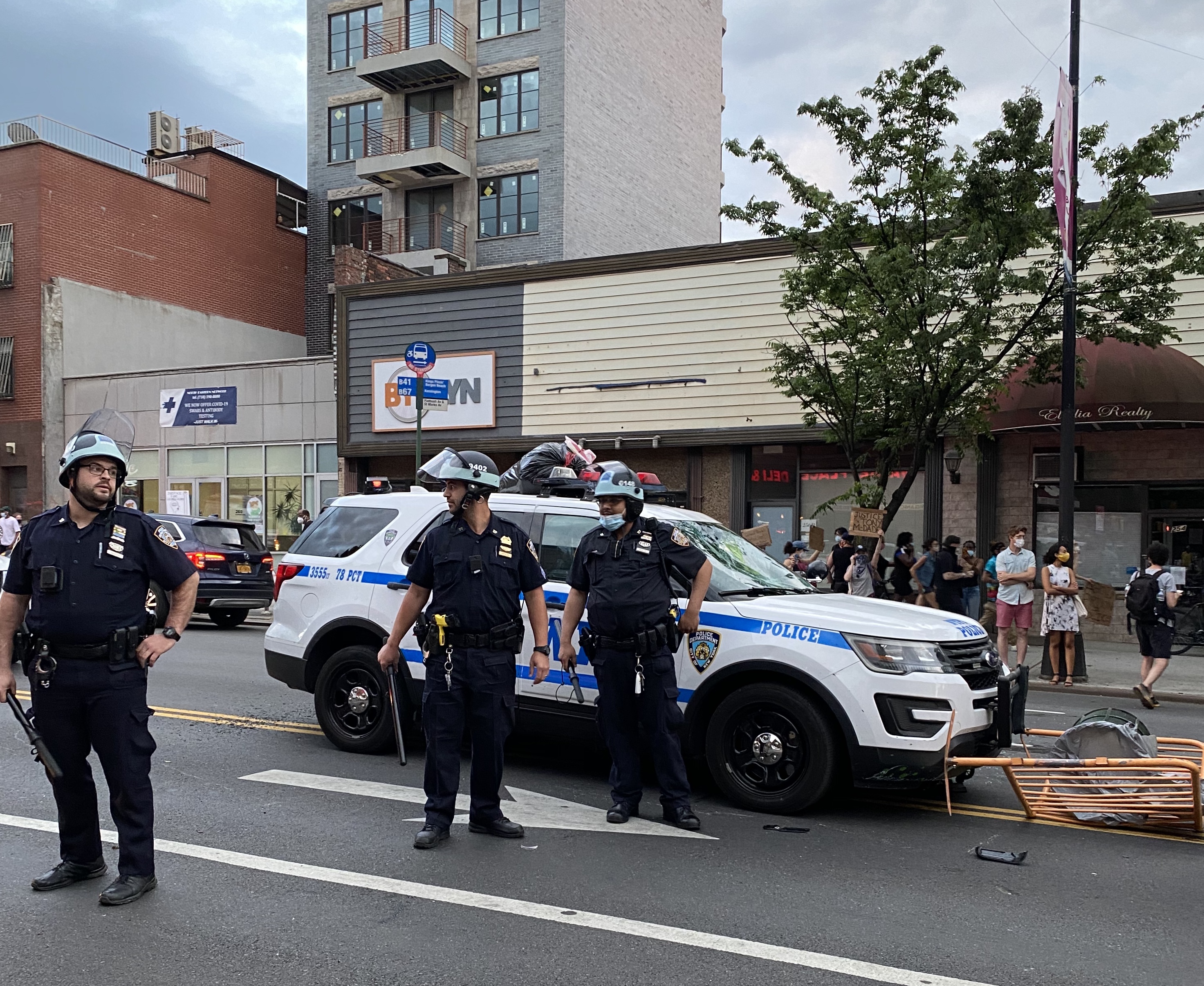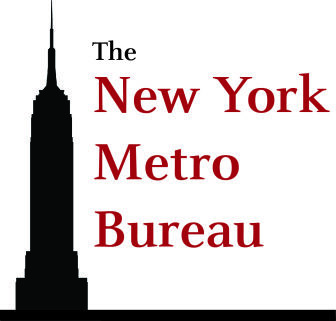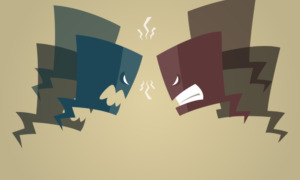
Parker Quinlan
Officers surround a squad car on Flatbush Avenue in Brooklyn after it ran into a crowd of protestors on May 30.
NEW YORK — After multiple reports of police using excessive force against anti-police brutality protestors in New York and charges filed against only one NYPD officer, activists are questioning whether prosecutors across the city are taking the issue of brutality seriously.
NYPD officer Vincent D’Andraia was charged on Tuesday after the Brooklyn District Attorney’s Office alleges he shoved a young woman, later identified on Twitter as 20-year-old Dounya Zayer.
 In a video from the incident, D’Andraia can be seen violently shoving Zayer onto the ground, causing her to roll into a curb. Zayer was later taken to a hospital and treated for a concussion, according to a video she shared on social media.
In a video from the incident, D’Andraia can be seen violently shoving Zayer onto the ground, causing her to roll into a curb. Zayer was later taken to a hospital and treated for a concussion, according to a video she shared on social media.
Though D’Andraia is not the first New York Police Department officer to be captured on camera using what appear to be overly aggressive policing tactics, he has been the first officer charged since protests began in May.
In various videos posted to social media, officers have been shown beating protestors with batons, even at one point driving squad cars into a group of protestors in Brooklyn.
D’Andraia was charged with third-degree assault, fourth-degree criminal mischief, second-degree harassment and third-degree menacing. An NYPD sergeant, who did not want his name used because of potential punishment for breaking the NYPD’s policy of not speaking to the press, disagreed with the charges, saying the officer was just doing his job.
“He didn’t use any of his level two weapons,” said the Staten Island-based officer, who has 12 years on the force. “He didn’t use any of the mace, the taser, the baton. He pushed her, he pushed her away. She just happened to be a smaller female that fell all the way back and hit her head. I mean, I don’t know what other options there is. That’s the lowest-level option that he could’ve used other than him just standing there and letting her jump in his face.”
D’Andraia did not commit a crime, the sergeant said, but the NYPD should have told the public he was being punished internally.
“I’m sure he’s advised by the union to just go through the motions, this is just you know, again, is just a dog and pony show kind of thing again in my opinion,” the sergeant said. “Just to say yeah, OK, he was arrested and the courts will figure out the rest.”
The arrest has left a sour taste in officers’ mouths but they also understand why it happened, the sergeant said. He’s heard officers saying after the charges were filed that they’re worried that they cannot use any level of force.
“It’s pretty much just sitting there and taking it from the person and I mean, I don’t know many, forget police officers, I don’t know many human beings that would just sit there and take that from someone,” the sergeant said.
Union leader, protestor’s attorney disagree
The NYPD’s union, the Police Benevolent Association, reacted similarly. On Tuesday, President Pat Lynch spoke out against Brooklyn District Attorney Eric Gonzalez at a press conference, saying he won’t prosecute rioters but “is prosecuting a police officer whose boss sent him out to do a job in a bad situation in chaotic times.
“And you know what, my grey hair told me that was going to happen. Everyone walked away from him and there was no longer a boss standing next to him. The brass threw them under a bus,” Lynch said. “The DA said ‘We don’t have time to prosecute criminals, but we’ll prosecute you.’”
Zayer’s attorney, Tahanie Aboushi, rejected the claim that the arrest was simply to make an example out of the NYPD, saying that Zayer has been left chronically sick after her incident.
“She has pretty bad headaches, and vomiting that she can’t control, a lot of back pain,” Aboushi said. “Emotionally she has a lot of worry, and fear, she’s afraid to go outside by herself.”
Aboushi, who is running to replace Manhattan DA Cyrus Vance Jr., has been involved in both civil and criminal cases, primarily against police, for the last 12 years.
For their part, protestors remain concerned that prosecutors are not doing enough to hold police accountable for misconduct.
Devin Khan, 22, who has been a regular fixture at recent protests in Manhattan and Brooklyn, says the police, particularly those dressed in riot gear, are responsible for increased tensions. (Khan is the brother of Daryl Khan, the New York bureau chief for the JJIE.)
“A lot of it is just with their stance. The way they’re playing around with their batons. It looks like they’re ready for battle,” Khan said. “When you’re coming across the bridge [into Manhattan] and you’re just protesting, it kind of puts you into a mind state of well, I should be on defense, I should be ready for attack, just in case.”
Khan, who was struck by a police cruiser while protesting in Brooklyn on May 30, says he believes that prosecutors often do not go after police the same way they do protestors.
“I mean, we don’t even know who’s behind the wheel [of the cruiser]. … They’re not getting they’re not being held accountable to the same standards, and I think people are getting upset and angry.”
Illegal use of force can be ambiguous
Prosecutors have long struggled with holding police departments accountable, particularly given how they work closely together.
Kevin McCarthy, a former prosecutor who worked at both the Manhattan District Attorney’s office, and for the U.S. Attorney’s office in New Jersey, says holding officers accountable is more complex than just bringing charges.
“Even if you have independent investigators, you still need assistance from the police department itself,” he said. “You’ll need other witnesses who are police officers, you need information about assignments, about past incidents, perhaps. All sorts of information related to the alleged offense.”
Often prosecutors are hesitant to bring any charges without clear evidence of a specific crime having been committed, and that the case is viable, McCarthy said.
The issue of determining whether an officer has illegally used force can often be ambiguous, with state law giving officers immense discretion to determine appropriate force.
This uncertainty on the part of prosecutors can be frustrating for those involved, particularly now as video of police interactions with protestors has become so prevalent.
Khan recorded such a video during a June 2 protest. NYPD officers in Manhattan can be seen kneeling on the backs of protestors, and dragging one man off by his arms, allegedly for several blocks, according to Khan.
Though Khan says the marches began peacefully near the Manhattan Bridge, by the time they reached Union Square, police began to arrest protestors.
“They started beating people with batons, anyone they can, like anyone that’s like in their vicinity, start beating and they start making arrests,” he said.
That’s when Khan started recording. The video begins as police appear to be indiscriminately hitting protestors with batons, and trying to arrest individuals as shrieking protestors surround them.
It is unclear why the people in the video were being arrested. Khan believes it was related to curfew violations.
NYPD did not respond to comment when shown a copy of the video.
A spokesperson for the Manhattan District Attorney’s Office said they are investigating several incidents of police misconduct stemming from the protest. No official charges against any officers in Manhattan have been announced.
Though Aboushi praised Brooklyn DA Gonzalez for bringing criminal charges against D’Andraia, she is concerned prosecutors across the city are still too harsh on peaceful protestors.
Despite their lack of conflict training, protestors are often expected to de-escalate incidents with the police themselves, or risk being sent to the hospital, she said.






























